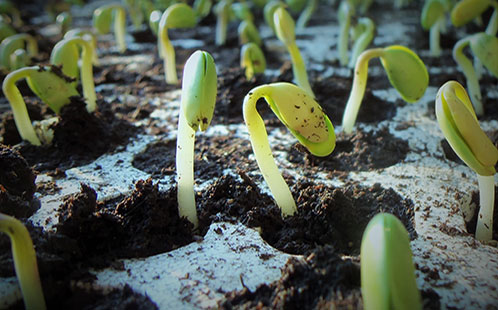From darkness to light: new findings unravel how plants control energy generation

Researchers at Western Sydney University and The Australian National University have discovered new chemical communication pathways that determine how a plant changes when it emerges from darkness in the soil to light.
When plants are grown in the dark, they are white or pale-yellow because they lack the chloroplasts that make leaves green. The yellowish colour is due to structures in the cell called etioplasts that later form green chloroplasts when the seedling detects light.
Dr Chris Cazzonelli, a Senior Lecturer in Plant Molecular Biology, and his research team at the Hawkesbury Institute for the Environment have discovered a new molecular mechanism that plants use to control the transformation from yellow etioplasts to green chloroplasts. This occurs via a carotenoid-derived metabolic signal that genetically triggers the expression of genes and production of proteins controlling the formation of green pigments that harvest light energy.
“For decades, plant scientists have been trying to uncover the chemical signaling pathways in plants that govern colour, fruit nutrition, yield, and other plant performance functions. Our team has focused on investigating the functions of chemicals derived from the yellow, orange and pinkish carotenoid pigments that enrich plant fruits with a dietary source of micronutrients”, said Dr Cazzonelli.
“This discovery sheds light on an essential, novel carotenoid-derived compound that controls plastid and plant development. Much like the missing piece of a complex jigsaw puzzle, our findings reveal that yellow plastids in dark-grown plants require a specific scaffolding body to help them transition into green energy-generating chloroplasts once the plant reaches the light. These scaffolds bind carotenoid pigments and ensure that when a seedling emerges from the soil through the leaf matter, it becomes enriched in chlorophyll and ready to harvest light,” co-author Dr Xin Hou said.
Through the use of special mutant varieties of plants that make an essential carotenoid-derived signal as well as chemical inhibitors that block its production, the WSU and ANU researchers were able to demonstrate how plants make use of this signal to control the green colouration of healthy chloroplasts when exposed to light.
This finding confirms that carotenoids are more than just structural components of energy-yielding plastids - they also provide chemical signals that control how plants germinate in the dark and produce light-harvesting green chloroplasts when they reach the surface.
Professor Barry Pogson highlighted that “chloroplasts are a light energy harvesting motor of the plant and we demonstrated that carotenoids provide an important signal in control of the chloroplasts structural development.”
Understanding carotenoid signalling pathways has opened up new opportunities to develop new plant functional compounds that could enhance colour, nutrition, flavor, and development of plants.
The research “A cis-carotene derived apocarotenoid regulates etioplast and chloroplast development” (opens in a new window) was published in the prestigious eLIFE journal ranked top 10 in Biochemisty, Genetics and Molecular Biology.
Image credit: Pixabay
ENDS
10 March 2020
Latest News

Western Sydney University receives transformational donation to support LGBTIQA+ community
Western Sydney University has welcomed a philanthropic donation from The Brennan Lynch Foundation.

Western Sydney University ranks among world’s best for 23 subjects
The University has been named as one of the world’s top universities for the study of 23 subjects in the latest edition of the QS World University Rankings by Subject, including being ranked in the top 50 for Nursing.

Western Sydney University receives landmark $7.9 million philanthropic gift from Harvey Norman to launch leadership academy, empowering young women in Western Sydney
Western has welcomed a landmark donation to establish the Harvey Norman® Young Women’s Leadership Academy Led by Katie Page.
Mobile options:

